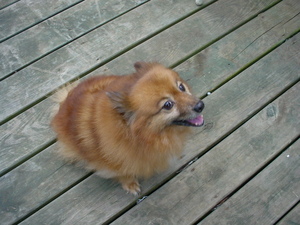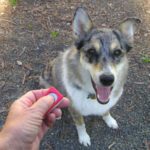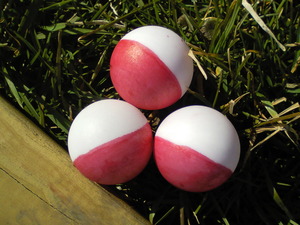In the fall of 2005 my Pomeranian was only a day away from being spayed when I found detected a lump on her stomach. I immediately became concerned and thought of breast cancer. Precious had been found on the side of the road and my vet estimated that she was probably around 5-7 years old. This unfortunately meant that she had been in heat several times. In order to help prevent breast cancer in dogs, you must have them fixed before they go into heat. I wish I had been able to do this for Precious. But, it was too late.
I took Precious to the vet the next day, for her surgery, and asked them about the lump on her stomach. They told me that it may or may not be breast cancer. The only way to be sure would be to send the mass off to have it tested. But, since she was being spayed that day, they would go ahead and remove the lump. This made me feel a little bit better. When I picked Precious up from the vet, it was hard to tell if the entire mass had been removed, because of her stitches. When her stitches were removed, I was thrilled that the lump was gone and started to put the bad thoughts of breast cancer out of my mind.
On Halloween of 2005, I found myself back in the vet’s office. Almost over night another lump developed on Precious’ stomach. This time the vet was able to take a sample and determine that the cells were cancerous. Again, Precious went into surgery and the breast cancer was removed. The vet told me that it would be seven years before the breast cancer would return, if it did return, which was unlikely. Unfortunately, this wasn’t true.
In October of 2006, I took Precious to be groomed. The groomer actually clipped her a lot shorter than I wanted, but this turned out to be very beneficial. After returning home I discovered that Precious had another small lump. This lump was actually smaller than a BB, but I was still concerned. After all, she had only had breast cancer removed a year ago. I took her back to the vet, who was unsure if it was breast cancer or not, but told me that it was highly likely that it was breast cancer. I immediately wanted it removed, but my vet calmed me down and told me to just keep an eye on it. If the lump started to grow, and reached the size of an almond, then it should be removed.
It’s now been 7 months and the lump I detected is exactly the same size as it was. Now, you may be wondering why the vet didn’t think that Precious should have the lump removed right after it was detected. The vet told me that if it was breast cancer, more lumps might appear later on, which would lead to even more surgeries. It was best to wait and see if the lump changed, or if any other masses appeared, and have them all removed at once. In the end, this really did make sense. Each time you put a dog under, you risk your dog’s life. If I were to put Precious through several surgeries she might not make it out one.
Now that I know my dog has breast cancer, there are several things I do to take care of her. If breast cancer has been detected in your dog, there are things you can do to take care of them.
Once breast cancer has been detected you will want to check your pet for more lumps around once a week. If another lump is detected, take your dog to the vet as soon as possible. Vets can be very busy, that’s why it’s important to remind them that breast cancer has been detected in your dog before. If the lump is big enough, you can request for them to take a sample of the lump to determine if more breast cancer can be detected.
If the lump is too small to test, your vet will probably instruct you to simply keep an eye on the lump. If this is the case, it is important to only check the lump around once a week. If you continue to check the lump every day after it’s been detected, you may think the lump is growing bigger when it’s not. Your vet will be able to tell you what size of lump should be removed. If the lump does keep growing bigger, you will want to have it removed as soon as possible.
Another thing you will want to do for dog, once breast cancer has been detected, is keep them properly groomed. If your dog has extremely long fur, you will want to have their stomach clipped as short as possible. It may be hard for lumps to be detected if the dog’s fur is too thick. Once your dog is groomed, feel of their belly thoroughly.
As I said before, once breast cancer has been detected in your dog, you will want to keep checking your dog’s stomach and chest for more lumps. To check for lumps, lay your dog on their back and feel all around the mammary gland. You may have to feel a few inches away from the mammary gland for some lumps to be detected. Once you have detected a lump, make note of its size. You may make a small note and keep it on your fridge or even draw a picture of its size. This will help you to determine if the lump has grown any bigger the next time you feel of it.
The most important thing you can do for your dog, after breast cancer has been detected, is to have them spayed. When you have them spayed, it will help some. Unfortunately, it doesn’t do a whole lot of good. The best time to have your dog spayed is before they ever go into heat. You will also want to keep a close relationship with your vet once breast cancer has been detected.







